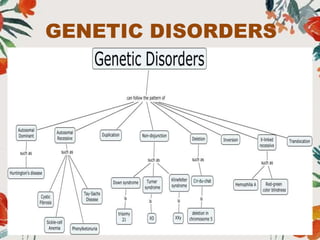
GENETIC DISORDERS.pptx
- 3. CYSTIC FIBROSIS (CF) • It is an autosomal recessive disorder. • Cystic fibrosis (CF) is a genetic disorder that affects mostly the lungs, but also the pancreas, liver, kidneys, and intestine. • Long-term issues include difficulty breathing and coughing up mucus as a result of frequent lung infections. • Other signs and symptoms may include sinus infections, poor growth, fatty stool, clubbing of the fingers and toes, and infertility in most males. • Different people may have different degrees of symptoms
- 4. PATHOPHYSIOLOGY • CF is caused by a mutation in the gene cystic fibrosis transmembrane conductance regulator (CFTR). • The CFTR protein is a channel protein that controls the flow of H2O and Cl- ions in and out of cells inside the lungs. When the CFTR protein is working correctly, ions freely flow in and out of the cells. However, when the CFTR protein is malfunctioning, these ions cannot flow out of the cell due to a blocked channel. This causes cystic fibrosis, characterized by the build up of thick mucus in the lungs.
- 5. TREATMENT • The inevitably fatal outcome in CF and the current lack of an effective treatment have led to attempts to develop a cured based on gene therapy. This involves delivering a modified virus containing the CFTR gene into the lungs using an inhaler. • Antibiotics and physiotherapy are used to lessen the effect of the mucous secretion but patients die as a result of their chronic lung disease by the age of 30. • The only effective treatment have at present is a heart lung transplant.
- 7. HUNTINGTON'S DISEASE • It is an autosomal dominant which affects the central nervous system. • Progressive breakdown (degeneration) of nerve cells in the brain. • Huntington's disease has a broad impact on a person's functional abilities and usually results in movement, thinking (cognitive) and psychiatric disorders. • Most people with Huntington's disease develop signs and symptoms in their 30s or 40s. But the disease may emerge earlier or later in life. • When the disease develops before age 20, the condition is called juvenile Huntington's disease. An earlier emergence of the disease often results in a somewhat different set of symptoms and faster disease progression.
- 8. SYMPTOMS Movement disorders • The movement disorders associated with Huntington's disease can include both involuntary movement problems and impairments in voluntary movements, such as: • Involuntary jerking or writhing movements (chorea) • Muscle problems, such as rigidity or muscle contracture (dystonia) • Slow or abnormal eye movements • Impaired gait, posture and balance • Difficulty with the physical production of speech or swallowing • Impairments in voluntary movements — rather than the involuntary movements — may have a greater impact on a person's ability to work, perform daily activities, communicate and remain independent.
- 9. SYMPTOMS Cognitive disorders:- Cognitive impairments often associated with Huntington's disease include: – Difficulty organizing, prioritizing or focusing on tasks – Lack of flexibility or the tendency to get stuck on a thought, behavior or action (perseveration) – Lack of impulse control that can result in outbursts, acting without thinking and sexual promiscuity – Lack of awareness of one's own behaviours and abilities – Slowness in processing thoughts or ''finding'' words – Difficulty in learning new information
- 10. SYMPTOMS • Psychiatric disorders • The most common psychiatric disorder associated with Huntington's disease is depression. This isn't simply a reaction to receiving a diagnosis of Huntington's disease. Instead, depression appears to occur because of injury to the brain and subsequent changes in brain function. Signs and symptoms may include: – Feelings of irritability, sadness or apathy – Social withdrawal – Insomnia – Fatigue and loss of energy – Frequent thoughts of death, dying or suicide
- 11. Cont......... • Other common psychiatric disorders include: – Obsessive-compulsive disorder — a condition marked by recurrent, intrusive thoughts and repetitive behaviours – Mania, which can cause elevated mood, overactivity, impulsive behaviour and inflated self- esteem – Bipolar disorder — a condition with alternating episodes of depression and mania • In addition to the above symptoms, weight loss is common in people with Huntington's disease, especially as the disease progresses.
- 12. MANAGEMENT • There is no cure for HD, but there are treatments available to reduce the severity of some of its symptoms. • Exercises and therapies physical therapy, occupational therapy, and speech therapy that help reduced the symptoms. • Psychiatric symptoms can be treated with medications similar to those used in the general population.
